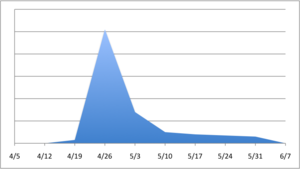CSSS 2009 Santa Fe-Projects & Working Groups
From Santa Fe Institute Events Wiki
| CSSS Santa Fe 2009 |
Brainstorming
- Disease ecology of media hype. How much and event gets covered in the news often appears to depends on how much it is already covered in the news. Often this distorts reality. For example, the number of searches for "swine flu" (a proxy for media hype), do not reflect the patterns of disease spread over the same period.


While the number of flu cases increased, the searches died off, as interest in the topic waned. It would be interesting to follow the origin, spread and extinction of media hype, maybe applying models commonly used to study the spread of disease. Alexander Mikheyev
Alhaji Cherif
you could look at the dynamics from agent-based (ABM) perspective. There is a recent paper by Epstein and colleague that focuses on the impact of fear on disease from agent-based perspective, but does not capture this dynamics. However, my collaborator and I are currently writing a paper on the same problem you just outline from mathematical epidemiological perspective. Our results show some interesting dynamics. I think its extension in ABM might provide richer dynamics.
Housing prices. The New York Times has a set of dramatic graphs showing the rise and fall of home prices in select cities. Again these graphs reminded me a bit of those produced by susceptible-infected-recovered models of disease spread. Maybe there is something to it? Or maybe this phenomenon is already well understood by economists? Alexander Mikheyev
- Movie Turnouts Which would be the more popular movie -- a combination of Steven Spielberg, Eddie Murphy and Gwyneth Paltrow, or Woody Allen, Dwayne 'the rock' Johnson, and Tom Cruise? Using the adaptation and turnout models presented by Nathan Collins, could we construct a prediction for gross movie receipts or even movie ratings? Nathan Hodas
- Climate network model. Requires someone with climatology knowledge. Lenton et al. recently published a paper listing 'policy-relevant' 'tipping elements' in the Earth's climate system and the temperature tipping points required to initiate them. (Basically, the tipping elements are components of the climate system where a bifurcation leading to a different stable state can be induced. The tipping point is the temperature at the bifurcation.) Surely, many of these tipping elements would have feedback effects on other tipping elements or the climate system as a whole. I would like to make a network model of these tipping elements and look at the tipping (or other) dynamics of the whole system. But Lenton et al. don't discuss these feedbacks much in their model, so we need some expert knowledge. Steven Lade
- Synchronised magma oscillations Requires someone with geological knowledge In a recent paper, which was also reported by New Scientist, Mjelde and Faleide report on seismological measurements that allowed them to infer past rates of magma flow in the plume generally though to rise beneath Iceland. When the plume is strong it thickens the Earth's crust at this point. They found the crust thickened approximately every 15 million years, and inferred that the magma plume must also have pulsed with this period. These pulsations have also been observed in the crust under Hawaii, with almost exactly the same period! Mjelde and Faleide hypothesise that there must be some giant heating oscillation in the Earth's core which drives these two oscillations at very different parts of the Earth. But other geologists are skeptical because of the huge energy required and lack of other evidence of such oscillations. But all this reminds me of the synchronisation phenomenon, where coupled oscillators, even if only weakly coupled, tend to synchronise. So the oscillations under Hawaii and Iceland may be generated independently, but have some weak coupling that has led them to synchronise. We can make coupled oscillator models, that's easy, but someone to provide more context on possible forms of coupling and their parameterisation is more what we need. They only observe about three periods of this oscillation and the data is quite imprecise so we can't do much direct data analysis, unfortunately. Steven Lade
- ""Implementing Synchronization using NetLogo""
Since I just learned about NetLogo, I look forward to the tutorial sessions and would like to implement a synchronization scheme of a group of entities. If I find out how the fireflies synchronize themselves, then that would be an option. Of course, I'll be surprised if this has not been done before in NetLogo. I'll welcome any help and suggestions.
- The Global Spread of Cricket: No I'm not actually intending to study this particular topic. But there is one interesting article published in 2005 (Kaufman and Patterson, American Sociological Review) that examined why cricket continues to be popular in many British-influenced societies while it is not in the U.S. and Canada. This is interesting given the fact that cricket was very popular in the two countries and that the first official international cricket match took place between the two countries in the mid-19th century. So, not only how cultures, ideas, technologies, etc. diffuse across nations, populations, and so on, but also mechanisms that influence the retention after the initial adoption merit serious attention I think. One possible topic include is modern contraceptive use in developing countries. I guess modeling such mechanisms would require taking into account the models presented by Nathan Collins and Peter Dodds, in addition to signed networks (Doreian). One difficulty of modeling this kind of mechanism is that both structural and individual factors should be considered Hirotoshi Yoshioka.

